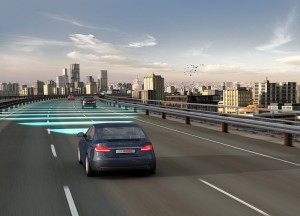Driver assistance systems can save lives. Nearly 680,000 – almost one-quarter – of the 2.95 million new cars registered in Germany last year can do just that – warn a tired driver before he causes an accident. This makes driver drowsiness detection the most frequently installed function in new cars. The 6 assistance systems used most often in new cars are listed below in order of increasing frequency:
ACC and ACC Stop & Go
Adaptive cruise control (ACC) usually works with a radar sensor and maintains a preset safety distance to the car ahead, even in heavy traffic. In the Stop & Go version, ACC slows a car down in a traffic jam, even stopping it completely. If the car has an automatic transmission, it restarts the engine once traffic gets moving again. Of the new cars registered in Germany in 2013, 4% have ACC or ACC Stop & Go.
Road-sign recognition
In 2013, 4% of all new cars featured road-sign recognition, which makes it easier for drivers to navigate the ‘road-sign jungle.’ A video camera reads traffic signs and presents relevant information as symbols in the dashboard. Bosch has also developed a free road-sign recognition solution for smartphone users. The ‘myDriveAssist’ app, available from the App Store and Google Play, uses the smartphone’s internal camera to recognise road signs.
Lane assistants were installed in 10% of all new cars registered in 2013. These assistants comprise three systems. The lane-departure warning system prevents accidents by warning the driver when he unintentionally leaves the lane. The lane-keeping assistant steers the car gently but firmly in the opposite direction when the car gets too close to the edge of the lane. By contrast, the lane-changing assistant monitors the area alongside and diagonally to the rear of the vehicle. A warning lamp on the side mirror warns the driver whenever another car is approaching at speed from behind or if one is already present in the blind spot.
Automatic Emergency braking
Rear-end collisions are among the worst accidents on the road, especially if pedestrians or cyclists are involved. When the system identifies a possible obstacle, the assistant prepares the braking system for an emergency stop, or automatically triggers one if the driver fails to react. This kind of predictive pedestrian protection will be required, starting in 2016, to qualify for Euro NCAP’s highest rating of 5 stars. Up to 72% of all rear-end collisions in Germany that result in personal injury could be avoided if all vehicles had an automatic emergency braking system. In 2013, 11% of all new cars had one installed.
Intelligent headlight control
When driving at night or in a tunnel, the assistant automatically turns the low-beam headlights on-or-off as required. If the headlight control sees no cars in front or oncoming traffic, it also automatically switches on the high-beams (provided the vehicle isn’t in a built-up area). Intelligent headlight controls can also constantly adjust the headlights to the course of the road or continuously switch between low and high beams. 20% of new cars registered in 2013 had intelligent headlight control.
Drowsiness detection
Microsleep, diminishing concentration, and fatigue while at the wheel are highly dangerous and cause many accidents. Bosch’s driver drowsiness detection system constantly analyses the driver’s steering behaviour using a steering angle sensor or the electrical power steering to spot patterns typical of fatigue. It then sends an auditory or visual signal telling the driver to take a break before he or she begins to nod off. Drowsiness detection systems were applied in 23% of new cars registered in 2013.
In developing the ABS and ESP systems, Bosch laid the foundation for safe driving. Cars are using sensors to gradually learn how to ‘see’ and perceive their environment. Powerful computers ensure that the assistance systems react rapidly and think as well as a good driver.







Leave a Reply